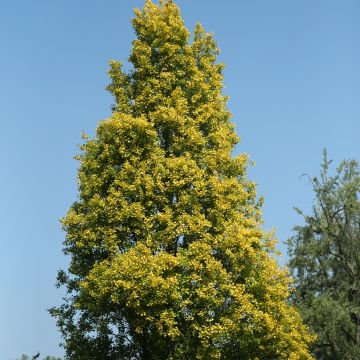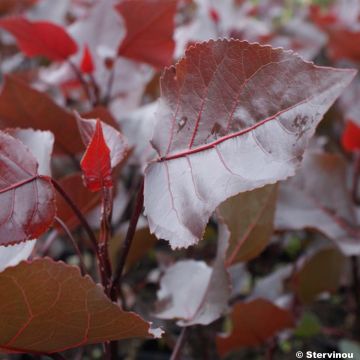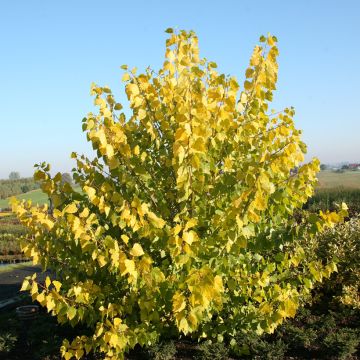

Populus nigra - Peuplier noir
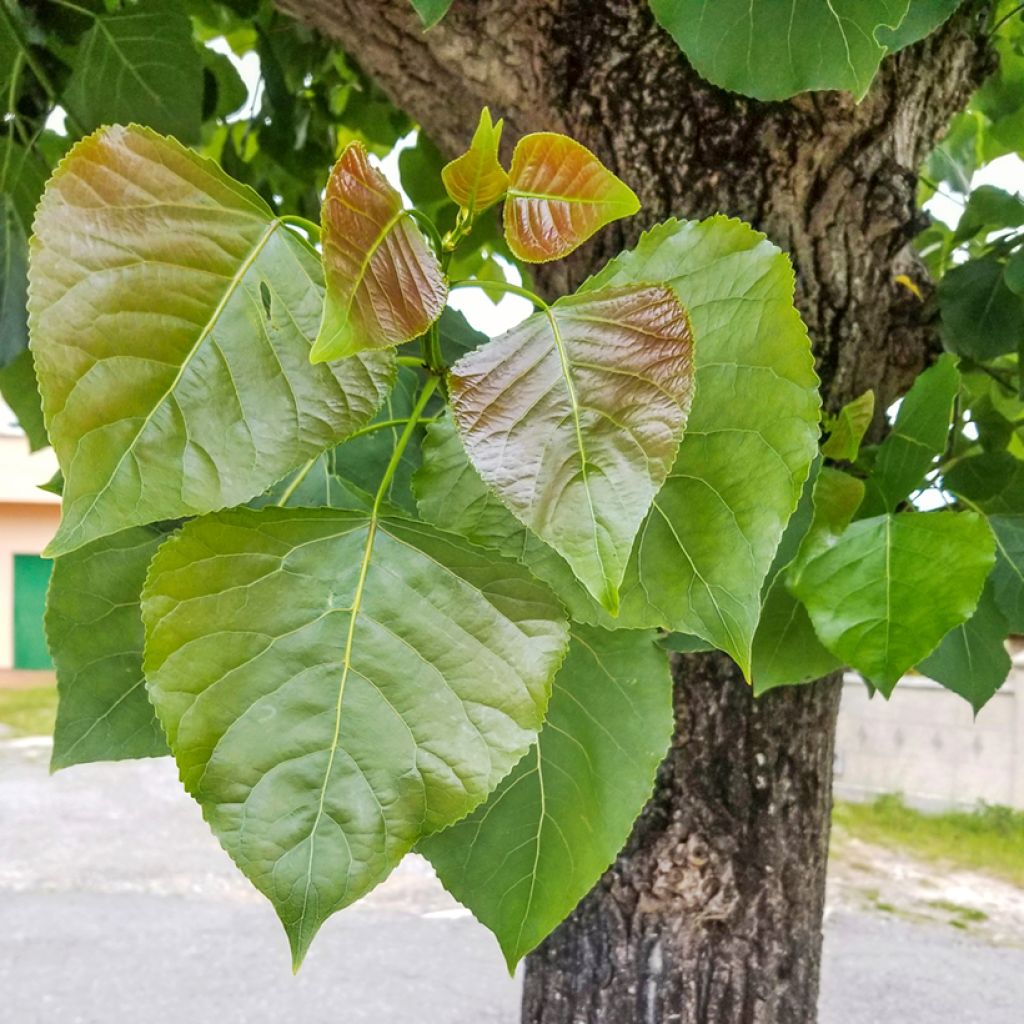

Populus nigra - Peuplier noir


Populus nigra - Peuplier noir


Populus nigra - Peuplier noir


Populus nigra - Peuplier noir


Populus nigra - Peuplier noir
Populus nigra - Black Poplar
Populus nigra
Black Poplar
Why not try an alternative variety in stock?
View all →This plant carries a 24 months recovery warranty
More information
We guarantee the quality of our plants for a full growing cycle, and will replace at our expense any plant that fails to recover under normal climatic and planting conditions.
Oversize package: home delivery by special carrier from €6.90 per order..
Express home delivery from €8.90.
Does this plant fit my garden?
Set up your Plantfit profile →
Description
Black Poplar, in Latin Populus nigra, which should not be confused with the Italian Poplar. It is the typical tree of rivers, banks, and riparian woodland, unfortunately becoming quite rare in Europe in favour of its hybrids and varieties. It is a tall deciduous tree with a dark, slender, irregular silhouette. It has rustling foliage, which is a shiny dark green colour that turns beautiful golden yellow in autumn. With rapid growth and good longevity, this native poplar is less susceptible to diseases than its hybrids. Superb as a large windbreak curtain, it thrives in moist soils.
Populus nigra belongs to the family Salicaceae. It is native to central and southern Europe, temperate Asia, and northern Africa. Adapted to cool to wet soils, this poplar develops a very extensive and widespread root system and tends to sucker. For this reason, it should be planted far away from buildings, at least 30 m (98ft). The black poplar can reach a height of 30m (98ft) and a width of 9m (29ft), and its growth is fast. This tree, very resistant to cold, can live for 400 years.
The black poplar develops a vertical trunk that rises to the top of the crown, with large secondary branches and multiple fine branches that are more or less erect. It branches quite low on the trunk. This forms an irregular crown. Over time, on mature specimens, its dark brown to blackish bark, becomes rough, with a characteristic diamond pattern. Sometimes the trunk shows large growths called gnarls. The young bark is smooth, thin, and greyish in colour. Small buds appear in early spring, attached to the branches. Its small triangular to diamond-shaped leaves, shiny dark green, turn yellow in October before falling. The black poplar is a dioecious plant, meaning there are separate male and female individuals. Flowering occurs in March-April. The inflorescences are pendulous catkins: male catkins, without peduncles, are reddish-violet, while female catkins hanging from a peduncle are tinted yellowish-green. After wind pollination, the female trees bear fruits grouped in clusters, and the cottony seeds are dispersed by the wind.
The Black Poplar is best suited for large gardens or parks. It is perfect, for example, along watercourses or near ponds and large natural pools. It could be associated with the common alder, willow, and ash, which also appreciate the proximity of water. This tree, when densely planted, can also create large windbreak screens. Like all native species, it is valuable for biodiversity.
Report an error about the product description
Populus nigra - Black Poplar in pictures


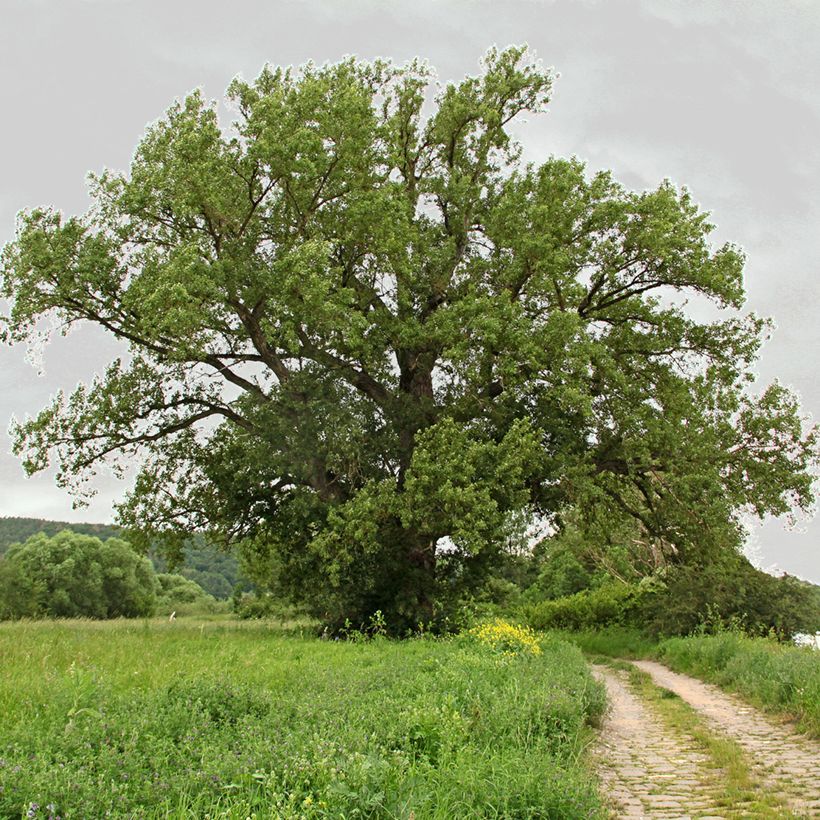

Plant habit
Flowering
Foliage
Botanical data
Populus
nigra
Salicaceae
Black Poplar
Western Europe
Other Populus - Poplar
Planting and care
Plant Populus nigra in any well-cultivated, rich, and moist soil. It requires a sunny position. This tree prefers the riversides and alluvial valleys. However, it can tolerate normal soils in a well-watered climate. If necessary, perform maintenance pruning before the foliage appears, removing diseased or dead wood and intertwined branches. This tree may be susceptible to certain diseases (galls) without serious consequences. Poplar canker, caused by a pathogenic fungus, can be more virulent, especially in individuals weakened by poor growing conditions (too dry or poor soil). The poplar is the host of an elegant night butterfly called the Poplar Hawk-moth (Laothoe populi).
Planting period
Intended location
Care
This item has not been reviewed yet - be the first to leave a review about it.
Haven't found what you were looking for?
Hardiness is the lowest winter temperature a plant can endure without suffering serious damage or even dying. However, hardiness is affected by location (a sheltered area, such as a patio), protection (winter cover) and soil type (hardiness is improved by well-drained soil).

Photo Sharing Terms & Conditions
In order to encourage gardeners to interact and share their experiences, Promesse de fleurs offers various media enabling content to be uploaded onto its Site - in particular via the ‘Photo sharing’ module.
The User agrees to refrain from:
- Posting any content that is illegal, prejudicial, insulting, racist, inciteful to hatred, revisionist, contrary to public decency, that infringes on privacy or on the privacy rights of third parties, in particular the publicity rights of persons and goods, intellectual property rights, or the right to privacy.
- Submitting content on behalf of a third party;
- Impersonate the identity of a third party and/or publish any personal information about a third party;
In general, the User undertakes to refrain from any unethical behaviour.
All Content (in particular text, comments, files, images, photos, videos, creative works, etc.), which may be subject to property or intellectual property rights, image or other private rights, shall remain the property of the User, subject to the limited rights granted by the terms of the licence granted by Promesse de fleurs as stated below. Users are at liberty to publish or not to publish such Content on the Site, notably via the ‘Photo Sharing’ facility, and accept that this Content shall be made public and freely accessible, notably on the Internet.
Users further acknowledge, undertake to have ,and guarantee that they hold all necessary rights and permissions to publish such material on the Site, in particular with regard to the legislation in force pertaining to any privacy, property, intellectual property, image, or contractual rights, or rights of any other nature. By publishing such Content on the Site, Users acknowledge accepting full liability as publishers of the Content within the meaning of the law, and grant Promesse de fleurs, free of charge, an inclusive, worldwide licence for the said Content for the entire duration of its publication, including all reproduction, representation, up/downloading, displaying, performing, transmission, and storage rights.
Users also grant permission for their name to be linked to the Content and accept that this link may not always be made available.
By engaging in posting material, Users consent to their Content becoming automatically accessible on the Internet, in particular on other sites and/or blogs and/or web pages of the Promesse de fleurs site, including in particular social pages and the Promesse de fleurs catalogue.
Users may secure the removal of entrusted content free of charge by issuing a simple request via our contact form.
The flowering period indicated on our website applies to countries and regions located in USDA zone 8 (France, the United Kingdom, Ireland, the Netherlands, etc.)
It will vary according to where you live:
- In zones 9 to 10 (Italy, Spain, Greece, etc.), flowering will occur about 2 to 4 weeks earlier.
- In zones 6 to 7 (Germany, Poland, Slovenia, and lower mountainous regions), flowering will be delayed by 2 to 3 weeks.
- In zone 5 (Central Europe, Scandinavia), blooming will be delayed by 3 to 5 weeks.
In temperate climates, pruning of spring-flowering shrubs (forsythia, spireas, etc.) should be done just after flowering.
Pruning of summer-flowering shrubs (Indian Lilac, Perovskia, etc.) can be done in winter or spring.
In cold regions as well as with frost-sensitive plants, avoid pruning too early when severe frosts may still occur.
The planting period indicated on our website applies to countries and regions located in USDA zone 8 (France, United Kingdom, Ireland, Netherlands).
It will vary according to where you live:
- In Mediterranean zones (Marseille, Madrid, Milan, etc.), autumn and winter are the best planting periods.
- In continental zones (Strasbourg, Munich, Vienna, etc.), delay planting by 2 to 3 weeks in spring and bring it forward by 2 to 4 weeks in autumn.
- In mountainous regions (the Alps, Pyrenees, Carpathians, etc.), it is best to plant in late spring (May-June) or late summer (August-September).
The harvesting period indicated on our website applies to countries and regions in USDA zone 8 (France, England, Ireland, the Netherlands).
In colder areas (Scandinavia, Poland, Austria...) fruit and vegetable harvests are likely to be delayed by 3-4 weeks.
In warmer areas (Italy, Spain, Greece, etc.), harvesting will probably take place earlier, depending on weather conditions.
The sowing periods indicated on our website apply to countries and regions within USDA Zone 8 (France, UK, Ireland, Netherlands).
In colder areas (Scandinavia, Poland, Austria...), delay any outdoor sowing by 3-4 weeks, or sow under glass.
In warmer climes (Italy, Spain, Greece, etc.), bring outdoor sowing forward by a few weeks.

































